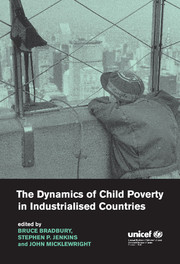Book contents
- Frontmatter
- Contents
- List of figures
- List of tables
- Notes on the contributors
- Acknowledgements
- 1 Beyond the snapshot: a dynamic view of child poverty
- Part I Issues and cross-national evidence
- Part II Topics in child poverty dynamics
- 5 Income mobility and exits from poverty of American children
- 6 Child poverty in Germany: trends and persistence
- 7 Poverty among British children: chronic or transitory?
- 8 Child income poverty and deprivation dynamics in Ireland
- 9 Young people leaving home: the impact on poverty in Spain
- 10 Are children being left behind in the transition in Hungary?
- 11 Mobility and poverty dynamics among Russian children
- Summary and policy conclusions
- Index of authors
- Index by subject
10 - Are children being left behind in the transition in Hungary?
Published online by Cambridge University Press: 02 December 2009
- Frontmatter
- Contents
- List of figures
- List of tables
- Notes on the contributors
- Acknowledgements
- 1 Beyond the snapshot: a dynamic view of child poverty
- Part I Issues and cross-national evidence
- Part II Topics in child poverty dynamics
- 5 Income mobility and exits from poverty of American children
- 6 Child poverty in Germany: trends and persistence
- 7 Poverty among British children: chronic or transitory?
- 8 Child income poverty and deprivation dynamics in Ireland
- 9 Young people leaving home: the impact on poverty in Spain
- 10 Are children being left behind in the transition in Hungary?
- 11 Mobility and poverty dynamics among Russian children
- Summary and policy conclusions
- Index of authors
- Index by subject
Summary
Hungary during the transition
Before the economic and social transition of the 1990s, children in Hungary, as in other Central and Eastern European countries, benefited both from an absence of open unemployment and from generous family policies that included various child-related cash transfers (see Atkinson and Micklewright 1992 and Jarvis and Micklewright 1995). This is not to say that child poverty was entirely absent in the socialist period (see, for example, Szalai 1989), but it is reasonably true to say that the socialist regime in Hungary, as elsewhere, placed a higher premium on support to families than governments in most Western countries (Ferge 1991).
How have children fared since 1989? In the early years of the transition, between 1989 and 1993, Hungary faced serious economic hardship affecting the well-being of children as well as other groups in the population; GDP fell by nearly a fifth, employment and real wages declined, and registered unemployment increased from almost zero in 1989 to 14 per cent in 1993 – see figure 10.1. Although unemployment has fallen back somewhat during the recovery in output since 1994, employment has continued to decline as have real wages (in 1995–6).
These processes have been coupled with the weakening of the social safety net. From 1992 the unemployment benefit system turned less and less generous both in terms of the coverage of the unemployed and the amounts of benefit paid (Micklewright and Nagy 1996, 1999).
- Type
- Chapter
- Information
- The Dynamics of Child Poverty in Industrialised Countries , pp. 236 - 253Publisher: Cambridge University PressPrint publication year: 2001
- 4
- Cited by

